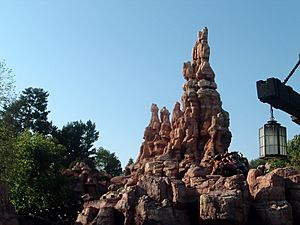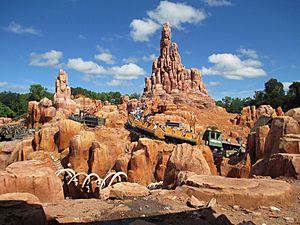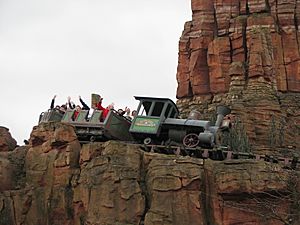Big Thunder Mountain Railroad facts for kids
Quick facts for kids Big Thunder Mountain Railroad |
|
|---|---|
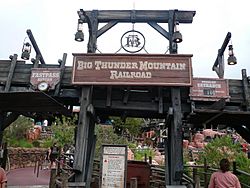
Big Thunder Mountain Railroad entrance at Walt Disney World.
|
|
| Disneyland | |
| Park section | Frontierland |
| Coordinates | 33°48′47″N 117°55′13″W / 33.8130°N 117.9204°W |
| Status | Operating |
| Opening date | September 2, 1979 |
| Replaced | Mine Train Through Nature's Wonderland |
| at at RCDB | |
| Magic Kingdom | |
| Park section | Frontierland |
| Coordinates | 28°25′14″N 81°35′05″W / 28.4205°N 81.5848°W |
| Status | Operating |
| Opening date | September 23, 1980 |
| Tokyo Disneyland | |
| Park section | Westernland |
| Coordinates | 35°37′57″N 139°53′02″E / 35.6326°N 139.8839°E |
| Status | Operating |
| Opening date | July 4, 1987 |
| Disneyland Park (Paris) | |
| Park section | Frontierland |
| Coordinates | 48°52′15″N 2°46′32″E / 48.8707°N 2.7756°E |
| Status | Operating |
| Opening date | April 12, 1992 |
| General statistics | |
| Type | Steel – Mine Train |
| Designer | Walt Disney Imagineering |
| Model | Mine Train |
| Track layout | Custom |
| Lift/launch system | Chain lift hill |
| Height | 104 ft (32 m) |
| Speed | 35 mph (56 km/h) |
| Inversions | 0 |
| Duration | varies (about 3 minutes) |
| Height restriction | 40 in (102 cm) |
| Manufacturer | Arrow Development (1979 California build, Florida) Dynamic Structures (2014 California rebuild) Vekoma (Paris, Tokyo) |
| Sponsor | Dai-ichi Life (Tokyo) |
| Restraints | Single Lap Bar |
|
|
|
|
|
|
|
|
|
Big Thunder Mountain Railroad is a super fun mine train roller coaster found in the Frontierland area of several Disney Parks around the world. You can ride it at Disneyland Park (California) and the Magic Kingdom at Walt Disney World. It's called Big Thunder Mountain Railroad there. At Tokyo Disneyland and Disneyland Park (Paris), it's known as Big Thunder Mountain. The ride is named after a make-believe rail line that the roller coaster pretends to be part of.
Contents
What's the Story Behind the Ride?
Each Big Thunder Mountain ride has a cool story, even if the details are a little different. They all share the same main idea.
Imagine it's the late 1800s. Gold was found on Big Thunder Mountain in the American Southwest. Suddenly, a small mining town became very busy! This town was called Rainbow Ridge in Disneyland, Tumbleweed in Florida, and Thunder Mesa in Disneyland Paris.
Mining was going great, and lots of mine trains were built to carry the gold. But the people didn't know that the mountain was a special, sacred place for local Native Americans. It was said to be cursed.
Soon, something terrible happened because of the mining. Depending on the park, this was either an earthquake (Disneyland and Disneyland Paris), a giant tsunami (Tokyo Disneyland), or a flash flood (Walt Disney World). The mines and town were left empty.
Later, something strange happened: the old mine trains started racing around the mountain all by themselves! No drivers, no crew! So, the Big Thunder Mountain Railroad was started. It let brave visitors ride these "possessed" trains.
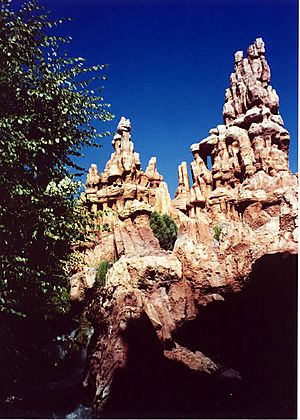
You won't hear this whole story directly on the ride. But the buildings you see in the queue look like old mining offices from the 1800s. At Disneyland, you can hear music and laughter from a saloon. You might even hear a typewriter in a newspaper office!
The mountains themselves look like the red rock formations from the American Southwest. The Disneyland version looks like the unique rock towers called hoodoos in Bryce Canyon National Park in Utah. The Florida, Tokyo, and Paris versions look like the tall, flat-topped hills found in Arizona and Utah's Monument Valley.
Disney's designers, called Imagineers, made sure the rocks looked natural. It seems like the tracks were built around the rocks, not the other way around. On most versions of the ride, you'll even see a dinosaur skeleton! There's also a cracked eggshell nearby. You might also see water shooting up from a lake on warm days. You can hear train sounds, like a steam whistle, even though the trains don't have one!
How the Ride Was Made
Big Thunder Mountain Railroad was created by Imagineer Tony Baxter and engineer Bill Watkins. The idea came from a bigger plan for a "Western River Expedition" at Magic Kingdom. This was supposed to be a huge western area with many rides, including a runaway mine train.
But building the whole Western River Expedition was too expensive. So, Tony Baxter suggested building just the mine train ride by itself.
The project was put on hold for a bit while Space Mountain was being built. But this delay was actually good! It meant Big Thunder Mountain Railroad was one of the first Disney rides to use computers in its design. This helped make the ride smoother.
The first Big Thunder Mountain Railroad opened at Disneyland in 1979. The Magic Kingdom's version in Florida, which is bigger, opened in 1980. Tokyo Disneyland's ride opened in 1987, and Disneyland Paris opened its version in 1992. The Paris ride is special because it's on a big island in the middle of the Rivers of the Far West. You get there by going through tunnels under the water! It's also the only Big Thunder Mountain that opened on the very first day of its park.
Hong Kong Disneyland and Shanghai Disneyland don't have a Big Thunder Mountain. But Grizzly Gulch at Hong Kong Disneyland has a similar feel. Its main ride, Big Grizzly Mountain Runaway Mine Cars, is also a runaway mine train!
Important Dates for Big Thunder Mountain
- 1972-73: The idea for Big Thunder Mountain Railroad was first thought of for Walt Disney World.
- 1974: The project was paused again because Space Mountain was being built.
- 1977: Building the ride began at Disneyland.
- September 2, 1979: Big Thunder Mountain Railroad officially opened at Disneyland.
- November 15, 1980: Big Thunder Mountain Railroad officially opened at Walt Disney World's Magic Kingdom.
- July 4, 1987: Big Thunder Mountain officially opened at Tokyo Disneyland.
- April 12, 1992: Big Thunder Mountain officially opened at Disneyland Paris when the park opened.
- March 17, 2014: Big Thunder Mountain Railroad reopened at Disneyland after a long 14-month update. It got new tracks, trains, and cool new effects!
- November 2, 2015: Big Thunder Mountain closed at Disneyland Paris for a year-long update.
- August 8, 2016: Big Thunder Mountain Railroad closed at Magic Kingdom for a 4-month update.
- December 6, 2020: Big Thunder Mountain Railroad at Magic Kingdom closed for another update. It was planned to reopen in 2021 for Walt Disney World's 50th Anniversary.
Remembering the Old Ride
At Disneyland, Big Thunder Mountain Railroad was built where an older ride, the Mine Train Through Nature's Wonderland, used to be. You can find some nods to the old ride in the Disneyland version.
- A small Western town, called Rainbow Ridge, is next to the ride's lines. This town used to overlook the old mine train's loading area.
- You'll see a Western saloon, a hotel, and other old-timey buildings.
- Many of the animal robots (animatronics) on the ride were actually from the older attraction!
- Look for the Rainbow Caverns (glowing pools of water) by the first lift hill.
- Also, check out the wobbly rocks in the third lift hill tunnel. These are all tributes to the past.
- The name "Big Thunder" itself came from a large waterfall on the old mine train tour.
What's in a Name?
At Magic Kingdom and Disneyland, the ride is called "Big Thunder Mountain Railroad." But in Tokyo and Paris, they dropped the "Railroad" part, calling it "Big Thunder Mountain." Even so, the full name is still printed on the trains! Sometimes, people just call it "Big Thunder" or "Thunder Mountain."
A Surprising Discovery
In 2016, a doctor found something interesting. Some of his patients said they passed kidney stones after riding Big Thunder Mountain Railroad at Walt Disney World! The doctor even tested this with a 3D model of a kidney. He rode the coaster over 20 times! His study showed that riding the coaster might help kidney stones pass, especially depending on where you sit in the train.
What's the Ride Like?
Disneyland Version
Even though the Magic Kingdom version was designed first, Disneyland's ride opened earlier. The track layout is a mirror image. This puts the ride to the right of Rivers of America at Disneyland. At Walt Disney World, it's on the left.
The Disneyland mountains look like the rounded, muted colors of Bryce Canyon in Utah. The other parks have sharper, brighter mountains like Monument Valley.
When you enter the line, you walk through a narrow rock path. The walls were made from 100 tons of real gold ore!
Your train leaves the outdoor station and goes into a tunnel filled with bats. You turn right, then left, and climb the first lift hill. This hill takes you through a cave with pointy stalactites. After the lift, the train drops and turns. You'll hear coyotes howling as you dive into another cave. The train slows down a bit, then climbs the second lift hill. At the top, a robot goat bleats at you!
The train drops again, spirals down, and shoots through a small canyon. You drop into a mining camp, slow down, and turn left into another tunnel. This is the third lift hill. As you climb, the tunnel looks like it's exploding with dynamite! Fake smoke blasts in your face.
The train drops towards the river, turns, and goes through a short tunnel. You pass through the ribcage of a T-rex skeleton! The train slows down for the last time. Then, you travel past the buildings of Rainbow Ridge as you return to the station.
Disneyland's Big Thunder is the only one with an outdoor station. All the others have indoor stations. In 2013, the ride closed for a big update. It got new tracks, trains, and effects. It reopened in 2014.
Magic Kingdom Version
The Magic Kingdom's ride layout is very similar to Disneyland's. But there are a few differences.
You board the trains in an indoor station. Your train leaves, turns left into a bat tunnel, and climbs the first lift hill. At the top, you pass under a waterfall and drop. The track then spirals through a short tunnel. You come out into the flooded town of Tumbleweed. You ride parallel to the Walt Disney World Railroad. The train goes over a shaky bridge before entering Davy Jones Mine. It slows down, turns left, and climbs the second lift hill.
At the top of the second lift, the train drops and spirals down. You go over a broken bridge. Leaving the spiral, the train goes over a small hill, turns, and drops through another tunnel. It slows down. Then, you turn right into a tunnel and climb the third lift hill. As you climb, it feels like an earthquake! The train cars sway from side to side.
After the lift, the train comes out of the tunnel, goes over a small bump, and drops towards the Rivers of America. You go through a short tunnel and over a bridge. Then, you turn right and pass through the ribcage of a T-Rex skeleton. The train slows down, turns left past geysers, and comes to a stop. Finally, you turn left back into the station.
The Florida version of the ride is bigger than Disneyland's. It covers 2.5 acres, which is 25 percent larger!
Tokyo Disneyland Version
Big Thunder Mountain at Tokyo Disneyland is a lot like the Magic Kingdom ride. But there are some small changes.
Instead of Tumbleweed, the track turns left and goes into a cave, like the California version. The end of the ride is also different. Instead of crossing back over the third lift hill drop, the track makes a big turn to the right. Then it drops out of a tunnel, through the boneyard scene, and into another short tunnel. The track turns right into the final brakes. The trains pass in front of the station building before returning to the loading area.
Disneyland Paris Version
The Paris version is mostly like the Florida ride. But it's special because it's on an island in the middle of the Rivers of the Far West. This is where Tom Sawyer's Island usually is. It's also the only Big Thunder Mountain that opened on the very first day of its park! It's the biggest Big Thunder Mountain at any Disney park.
The Paris version had a big update from November 2015 to December 2016. The brakes were fixed, scenery was repainted, and some cool things from the California version were added. These include rainbow pools of water in the first lift hill cave and new sound effects. There are also new lighting effects for the blasting scene on the third lift hill. Fun interactive games were even added to the queue line!
You get on the trains at a station on the mainland. The trains here look old and worn, which is unique. Right after leaving the station, your train dives into a tunnel that takes you under the Rivers of the Far West to the island! The train turns right and goes up a quick steep hill before climbing the first lift hill. As you come out of the dark underwater tunnel, you'll see stalactites and stalagmites. You can also hear bats flying above. On warmer days, a waterfall splits around the track at the top of the hill.
The train drops, turns left, goes through a small cave, and makes a big swooping right turn. If trains are sent out at the right time, it looks like you'll almost hit another train in the spiral!
After this turn, the train goes under the second lift hill. It makes a small hop, then turns left onto a bridge. You ride along the Rivers of the Far West, across the water from Phantom Manor. The track then suddenly drops through a broken part of the bridge! There's a camera here to take your picture. After dropping to the water level (with water jets making it look like a splash!), the trains turn left and hit the start of the second lift hill.
As the trains go up this lift hill, you might see two donkeys braying. A goat might be pulling on a shirt hanging on a clothesline! You'll also pass a steamroller and a mine elevator.
At the top of the lift, you might even see The Twilight Zone Tower of Terror at Walt Disney Studios Paris far away! Then the trains drop, turn left, and cross back under the lift hill. The track goes over another hill, and you pass a sign warning about a broken bridge. You then spiral down through a big 540-degree turn.
Leaving the spiral, the trains go through a short cave and over a quick "airtime" hill as they speed down a canyon. As the trains drop through a tunnel, you hear a loud gust of wind. Then, you turn right onto another bridge and enter a tunnel with "blasting" warning signs. This is the third lift hill.
As the train climbs the third hill, the tunnel looks like it's exploding! Fake smoke blasts in your face. The train goes over a small hill, then drops left onto a straight track next to the river. It speeds up as it enters the return tunnel. You'll see a swarm of bats in the tunnel as the train makes a sharp turn and goes down a steep drop to cross back under the water. The trains keep speeding through the dark until they pop out on the mainland. Another chain lift helps the train leave the tunnel. The train then coasts past the station, through the loading area, and turns left to re-enter the station.
Big Thunder Mountain in Movies and Books
In Movies
The sounds of Disneyland's Big Thunder Mountain Railroad trains were used in the 1984 movie Indiana Jones and the Temple of Doom. They were the sound effects for the mine cart chase scene! Later, Disneyland got its own Indiana Jones ride. Disney also bought the Indiana Jones movies in 2012.
In TV Shows
In 2013, the ABC network planned a TV show based on the ride called Big Thunder Mountain. But the idea was later stopped.
In Comic Books
In October 2014, Marvel Comics announced a five-issue comic book series about the ride. It came out in early 2015. This series was part of Marvel's "Disney Kingdoms" line. It told more of the story behind the ride and included ideas from Disney Imagineers.
Images for kids


